Physics II; Period 8
Alexis Cooley and Kim Jensen
Table of Contents
Background Information Problem Hypothesis Procedure Data Analysis
Hypothesis2 Data2 Analysis2 Conclusion Sources
Graphs Graphs2 Whole Paper in Text Format
(Note: We experienced some difficulties with this experiment so we decided to present you with all of our information, hence the 2.)
Throughout human history, we have tried to create original designs for weapons, which attack an enemy from a great distance. One of the most successful of these weapons was the catapult. Yet, many steps were taken before the catapult was created. First, the sling was produced to surmount the restrictions of the weak human arm. Next, hunters and soldiers invented the bow and arrow to advance in aim and velocity. Eventually, key advances in power and accuracy were achieved with the design of the catapult. The catapult was first invented around 400 BC by the Greeks. In fact it was the Greeks and Romans who first perfected the use of this weapon. After much improvement their catapults were able to throw sixty-pound rocks five football fields away (Catapults: Weapons). The catapult was the first form of field artillery, which was used in battles. The word itself comes from the two Greek words “kata” and “pultos”. “Kata” means downward and “pultos” refers to a small circular shield carried in battle. Katapultos was then taken to mean “shied piercer”. They were used as siege machines to surround and blockade a town or fortress from an army trying to capture it.
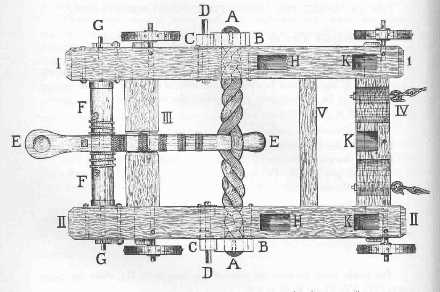
The very first catapults were created under the direction of Dionysius the Elder, ruler of the Greek colony of Syracuse, Sicily in 399 BCE. He wanted to give his city a strategic advantage in the upcoming war, so in order to prepare his city, Dionysius assembled large research and development teams to create new weapons (Pulis 2000). Greek artisans, under their ruler’s direction, fashioned the gastrophetes, or “belly bow,” modeled after the bow and arrow (2000). This weapon proved inadequate for their needs because it could only shoot arrows about 300 yards and it could not throw stones. Eventually, research led to the development of the ballista. The “substitution of torsion for tension” made this weapon more powerful than the previous one (2000). Next was the onager, or “wild donkey”. This launching apparatus had a single arm and was driven by torsion. The weapon’s range was extended because it united both the motions of throwing and flinging. The onager is the weapon most commonly related to the catapult.

The catapult was a new weapon for attackers, which made the advantage uneven for defenders during enemy siege (Griess 1986). While the defenders still had the capability to prepare for attack by building great walls, attackers, using catapults, could physically defeat these obstacles. Even during the thirteenth century, after the invention of cannons and mortars, catapults were still utilized on battlefields because they were easy to build on the site and were still capable of doing damage.
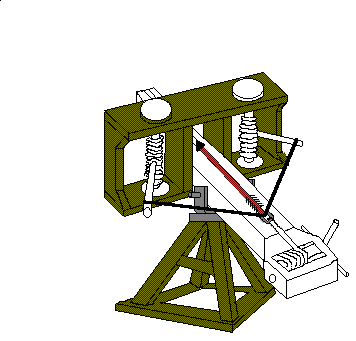
Catapults have evolved vastly since the days of Ancient Greece, but they are still present in the artillery of our modern army. The basic principles of the Greeks’ and Romans’ catapults have been preserved. For example, we have massive steam catapults, which are used to launch aircraft from carriers at sea (Catapults: Weapons, 2002). The major difference between these modern catapults is that they use compressed air rather than gravity, tension, or torsion. The benefit of this device is still present, the catapult provides a fast yet controlled energy source and a right angle for the launch. With a catapult objects can be thrown long distances with amazing accuracy.
Three properties can be exemplified in the use of a catapult: elasticity, energy, and force. Elasticity is seen in the measure of the stretch of the spring loaded in the catapult. This will demonstrate the accuracy of the delivery of the object being flung. Second, energy is present in the conversion of it from potential into kinetic energy. This could demonstrate and determine the range of the object. Finally, force can be studied and measured in the projectile motion. With our project, we will simply measure the initial velocity of the object as it leaves the throwing arm of the catapult.
Related Literature:
Through the Catapults: Weapons of Destruction site, we learned the basic principals and history of the catapult. The site explains the necessity for catapults in medieval warfare but does not thoroughly explain the physics of the catapult. The book by Thomas Griess, Ancient and Medieval Warfare was similar in content to the Catapults: Weapons of Destruction web page. It also included information about the origins of the catapult, and some modern day uses of it. In order to find information regarding the physics of the catapult, we used Lee Pulis’ book Construct-a-Catapult. This helped us with a very broad understanding of the physics at work behind a catapult. It explains the design, and the necessity for each part in the design. The problem with Pulis’ instructions is that they were for a very large catapult, at least 5 feet tall. It also included a lot of mechanics that we didn’t think we could pull off. So we found two sites that were geared specifically towards physics students. The first was an AP physics site, which laid out a very simplistic design. It offered a wide variety of possible variables, but we decided against their design, because it did not leave room for variables that could easily be measured. What we used to outline our final design were findings from a Boy Scout’s Building a Catapult page, which gives instructions for a catapult, which would easily let us measure any variable. Using the AP list of variables we decided to measure launch angle, and see how that determines throwing velocity. We did not find any project, which related specifically to the variable of launch angle, and when we began to build our catapult we realized measuring launch angle would be very ambiguous with the design we had chosen. So we changed our research question to how the length of the tail of the throwing arm effects launch velocity. We still found no specific project relating directly to this variable, but the design allows for easy, accurate measurements.
A catapult’s throwing arm has a tail which can be set to different lengths to minimize or maximize the throwing distance. We are going to find out the relationship between the lengths of the tail (the longer the tail, the shorter the throwing arm) and the launch velocity. Our hypothesis is that the shorter the throwing arm, the higher the launch velocity.
1.
Laid out
three 2 m boards in a triangle, with corners overlapping, and secured them
together where they crossed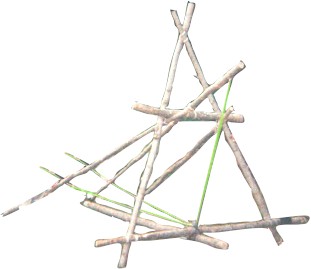
2. Secured two boards to the back of the triangle for support of the apparatus
3. Fastened a cross piece to the throwing arm about 1 meter from the bottom
4. Attached small shelves about 1/3 of the distance down the two front arms of the triangle
5. Placed the throwing arm through the hole and rested it on the shelves
6. Adjusted the end of the throwing arm’s length for each launch of the catapult
7. Launched the catapult by hitting the throwing arm with a large board
Length of Tail (Inches) Trial 1 Trial 2 Trial 3 Average Velocity (ft/s) Average Velocity (m/s)
19.5 29'5" 26'5" 23'6" 12.37 3.77
2.74 sec 1.82 sec 1.98 sec
22.5 10'9" 7'8" 6'3" 4.634 1.41
1.83 sec 1.77 sec 1.69 sec
16.5 23'10" 29' 29' 16.186 4.93
1.65 sec 1.7 sec 1.7 sec
The data is inconsistent. For example, for the tail with length 16.5 inches, the first trial went 23’10” in 1.65 seconds. Well the next two trials went about 5 feet farther in only .05 seconds. This data cannot be used to prove the hypothesis either correct or incorrect. The experiment should be repeated and with a different hypothesis.
Hypothesis:
A catapult’s throwing arm has a tail which can be set to different lengths to minimize or maximize the throwing distance. We are going to find out the relationship between the lengths of the tail (the longer the tail, the shorter the throwing arm) and the launch distance. Our hypothesis is that the shorter the throwing arm, the farther the launch distance.
Length of Tail (Inches) Distance (Inches)
Trial 1 Trial 2 Trial 3 Trial 4 Trial 5 Average
16.5 101 105 103.5 105.5 104.5 103.9
15.5 96 96 89 91.5 89.5 92.4
14.5 75 78.5 70.5 76.5 73.5 74.8
13.5 62 63 61 60 62 61.6
Length of Tail (m) Distance (m)
Trial 1 Trial 2 Trial 3 Trial 4 Trial 5 Average
0.4191 2.5654 2.667 2.6289 2.6797 2.6543 2.63906
0.3937 2.4384 2.4384 2.2606 2.3241 2.2733 2.34696
0.3683 1.905 1.9939 1.7907 1.9431 1.8669 1.90052
0.3429 1.5748 1.6002 1.5494 1.524 1.5748 1.56464
The longest tail (16.5 inches) did have the farthest launch distance of 103.9 inches. And the shortest tail, which measured 13.5 inches, had the shortest launch distance (61.6 inches). The trials are also much more consistent than in the first experiment. The distance of the longest tail varies by only 4.5 inches, as opposed to the almost 5 feet in the first experiment.
Our first hypothesis was not accepted as correct in this experiment. Our data was too inconsistent to draw any sort of conclusion out of it. Every time that the catapult was launched, there could have been different forces acting on it because of human error. Also, the weather conditions could have changed it because we did not take into account the wind factor. It could have blown the object off course or simply acted as a headwind to slow it down. But our second experiment proved to be more accurate. The length of the throwing arm did have an effect on the distance of the launch. The shorter that the throwing arm was, the greater distance of the flight. Of course there could have also been errors in this experiment, like human error and wind factor, but they were not as apparent the second experiment. What is strange, is that according to r*F= Torque, the longer the fulcrum got, the farther it should have launched. The data that we found contradicted this exactly. What must be the case is that when the tail of the fulcrum is shorter, it caused the object to launch higher, which shortened the horizontal flight. It also may have reached a length in which the small strength of the spring was overwhelmed, and therefore, the longer it got, the less more stress on the failing spring.

|
|
Time |
Distance |
|
19.5
inches |
2.74
sec |
29'5" |
|
|
1.82
sec |
26'5" |
|
|
1.98
sec |
23'6" |
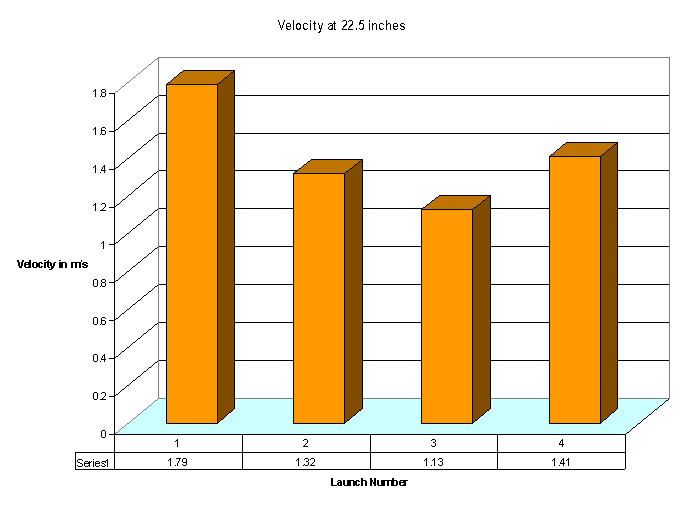
|
|
Time |
Distance |
|
22.5
inches |
1.83 |
10'9" |
|
|
1.77 |
7'8" |
|
|
1.69 |
6'3" |
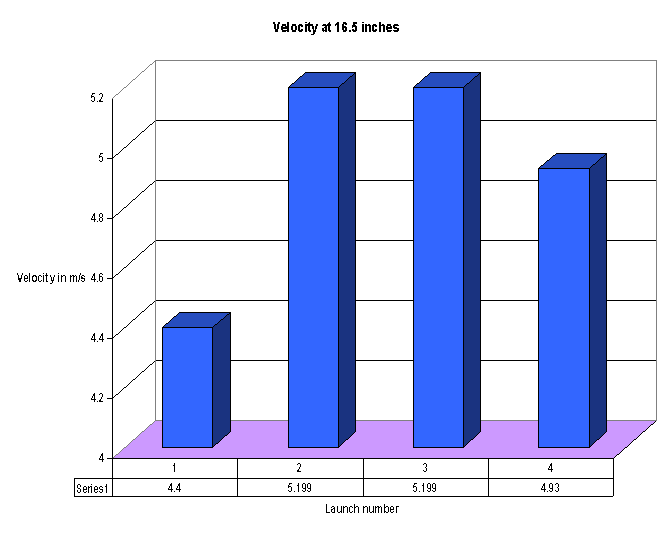
|
|
Time |
Distance |
|
16.5
inches |
1.62 |
23'10" |
|
|
1.7 |
29' |
|
|
1.7 |
29' |
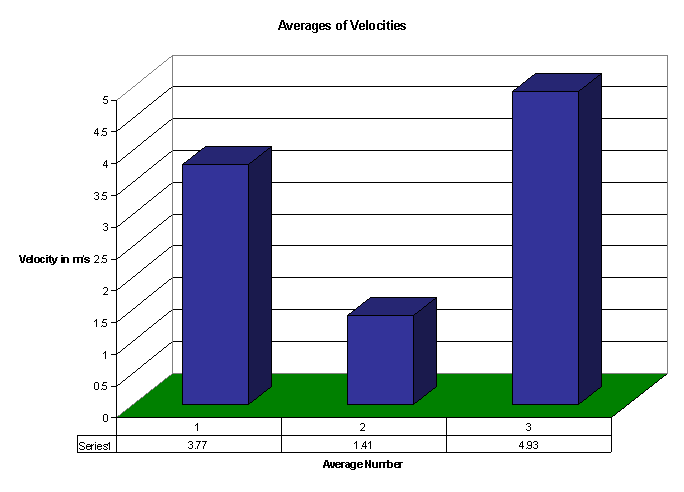
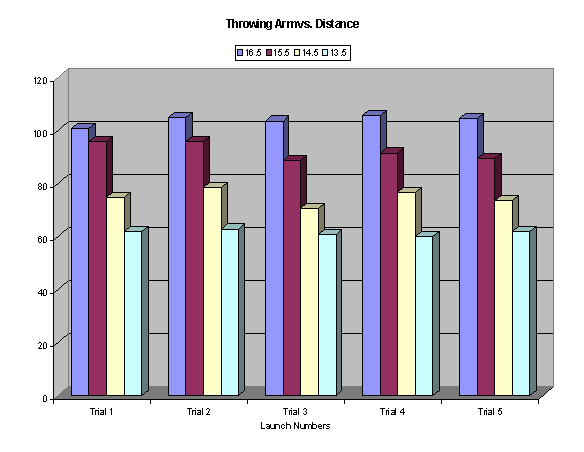

Building a Catapult. 10/31/02
<http://www.glenn.cockwell.com/scouting/scouting_catapult1.html>
This is a site for anyone interested in building a simple catapult. Instructions are easy to follow.
Catapults: Weapons of Destruction. 10/25/02.
< http://pages.emerson.edu/students/Carlo_Lim/catapults/Catapults.htm#Modern>
This is a site about the history of the Catapult. The information generally revolves around the catapult as a weapon and others that came before it.
Gende, Delores. “AP Physics Catapult Project.” 10/30/02 <http://apphysicsb.homestead.com/catapult.html>
A teachers guide to all information related to the catapult. This includes simple projects and background information.
Griess, Thomas ed. “Ancient and Medieval Warfare.” The West Point Military History Series.
United States: Avery Penguin Putnam, 1986.
Pulis, Lee. “Construct-a-Catapult.” Technical Educational Research Centers. United States:
NSTA Press, 2000.
Other Sources:
If you are interested in building a catapult, or other related weaponry, feel free to visit the sites that we encountered:
<http://www.trebuchet.com/plans.html> -This site is a list of links which relate to the history and construct of a catapult. There is also information on the Trebuchet.
<http://www.redstoneprojects.com/trebuchetstore/build_a_catapult.html>- This site is all about trebuchets. You can learn how to construct them and their background as well.

